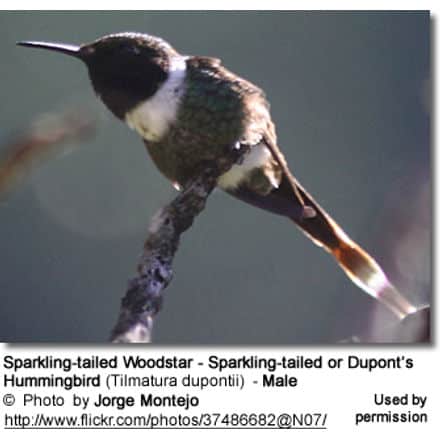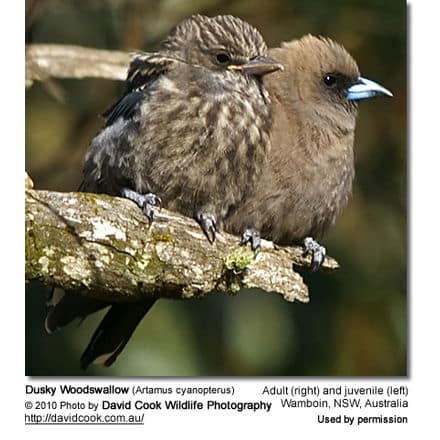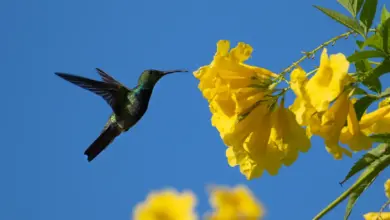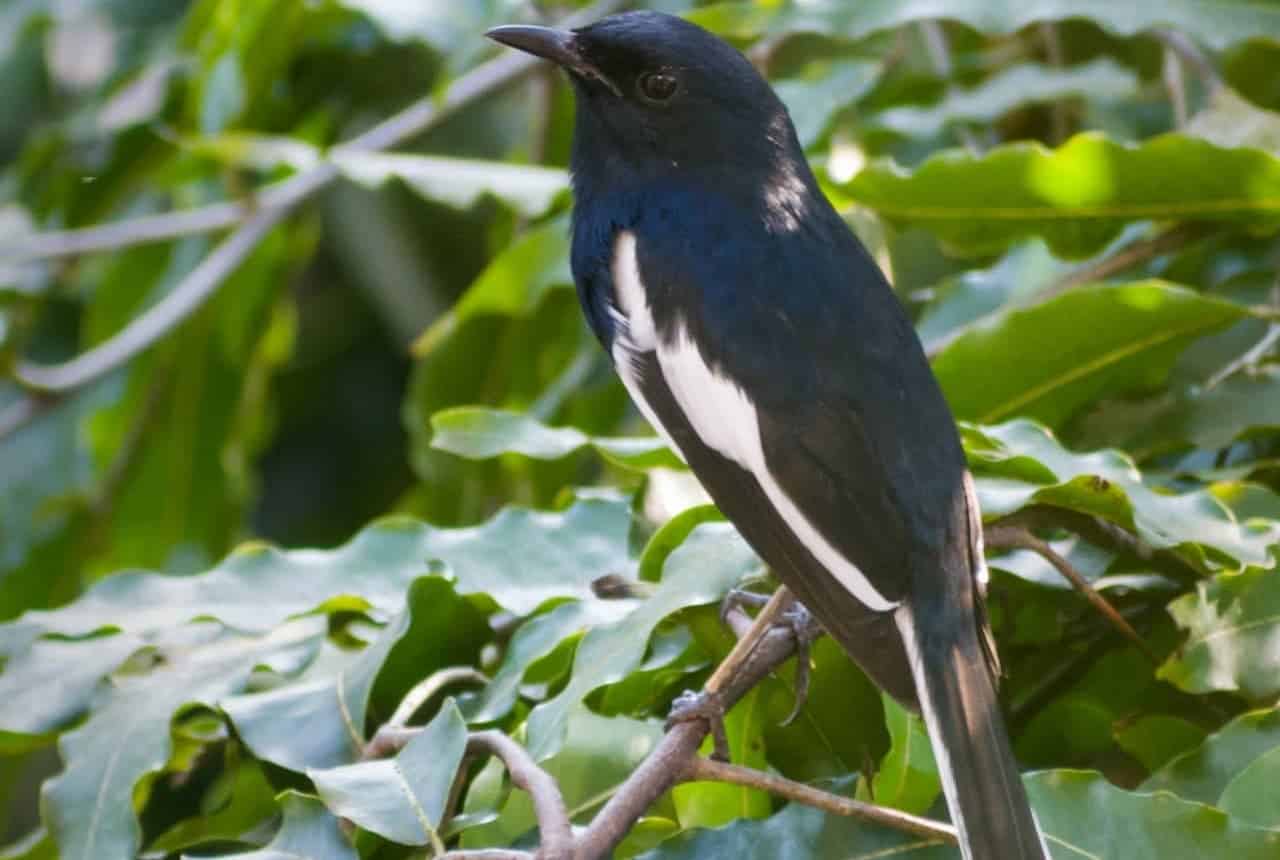Sparkling-tailed Woodstar – also known as Dupont’s or Sparkling-tailed Hummingbird
Sparkling-tailed Woodstar – also known as Dupont’s or Sparkling-tailed Hummingbird
Hummingbird Information
Overview … Alternate (Global) Names
Description … Calls / Vocalizations
Breeding / Nesting … Diet / Feeding
The Sparkling-tailed Woodstars – or the Sparkling-tailed or Dupont’s Hummingbirds (Tilmatura dupontii) – occur naturally in Mexico and Central America. This hummingbird was first registered in 1832 by René Primevère Lesson, a French surgeon and ornithologist.
Distribution / Habitat
The Sparkling-tailed Hummingbird occurs naturally in central and southern Mexico – from central Sinaloa, México and Veracruz nearly entirely along the Pacific coast to the southern state of Oaxaca and northern Chiapas. Another population is found in eastern Mexico between Veracruz and Puebla.
Further south, their range stretches through the highlands of Guatemala through El Salvador and Honduras to northern Nicaragua. They have also been reported as far south as Costa Rica.
These birds mostly inhabit open humid and dry (arid) pine-oak forests and areas with bushes and shrubs – at elevations from 0 to 8200 feet (~ 2,500 meters).
Sparkling-tailed Woodstars are mostly sedentary (non-migratory), except for some altitudinal movements after the breeding season.
Description
Size
These medium-sized hummingbirds measure from 2.6 – 3.94 inches (6.5 – 10 cm) in length – including the tail. The males are generally a little larger with a length of 3.54 to 3.94 inches (9 – 10 cm); and females usually are within the 2.6 – 3 inches (6.5 – 7.5 c m) range.
They weigh between 0.08 – 0.12 oz (2.4 – 3.3 grams).
Plumage Details / Adults
Sparkling-tailed Hummingbirds are most easily identified by the squarish white patches on the sides of the rump.
Males have long, forked, blackish tails with white bands that can be seen when folded. Their throats are glittering blue or bluish purple, with a white stripe below, across the chest until the nape (back of the neck). Their crowns (top of the heads), napes and back are green. Their abdomens are dusky green.
Females are cinnamon-colored on the face, throat, chest and abdomen. There is a dark stripe behind each eye. The tail is shorter, cleft and double-rounded; its inner feathers are green and the outer feathers are blackish tipped white.
Juvenile Description
Juveniles resemble the adult females.
Similar Species
They resemble the Mexican Sheartail (Doricha eliza) and the Beautiful Hummingbird / Sheartail (Calothorax pulcher); however, those have longer and more curved bills; their tails are longer and forked – except for the square tip.
The Sparkling-tailed Woodstars (Tilmatura dupontii) can be identified by the white patches on the rump and the characteristic coloration pattern of the tail.
Diet / Feeding
Sparkling -tailed Hummingbirds usually feed on nectar taking from various brightly colored, scented small flowers of trees, herbs, shrubs and epiphytes along established feeding routes.
They favor flowers with the highest sugar content (often red-colored and tubular-shaped) and seek out, and aggressively protect, those areas containing flowers with high energy nectar. They use their long, extendible, straw-like tongues to retrieve the nectar while hovering with their tails cocked upward as they are licking at the nectar up to 13 times per second. Sometimes they may be seen hanging on the flower while feeding.
Many native and cultivated plants on whose flowers these birds feed heavily rely on them for pollination. The mostly tubular-shaped flowers actually exclude most bees and butterflies from feeding on them and, subsequently, from pollinating the plants.
They may also visit local hummingbird feeders for some sugar water, or drink out of bird baths or water fountains where they will either hover and sip water as it runs over the edge; or they will perch on the edge and drink – like all the other birds; however, they only remain still for a short moment.
They also take some small spiders and insects – important sources of protein particularly needed during the breeding season to ensure the proper development of their young. Insects are often caught in flight (hawking); snatched off leaves or branches, or are taken from spider webs. A nesting female can capture up to 2,000 insects a day.
Males establish feeding territories, where they aggressively chase away other males as well as large insects – such as bumblebees and hawk moths – that want to feed in their territory. They use aerial flights and intimidating displays to defend their territories.
Breeding / Nesting
Little is known about their reproductive life. Birds in breeding condition have been sighted in August.
One can assume that their reproductive life is similar to that of other hummingbird species; namely that they are solitary in all aspects of life other than breeding; and the male’s only involvement in the reproductive process is the actual mating with the female. They neither live nor migrate in flocks; and there is no pair bond for this species. Males court females by flying in a u-shaped pattern in front of them. He will separate from the female immediately after copulation. One male may mate with several females. In all likelihood, the female will also mate with several males. The males do not participate in choosing the nest location, building the nest or raising the chicks.
The female is responsible for building the cup-shaped nest out of plant fibers woven together and green moss on the outside for camouflage in a protected location in a shrub, bush or tree. She lines the nest with soft plant fibers, animal hair and feather down, and strengthens the structure with spider webbing and other sticky material, giving it an elastic quality to allow it to stretch to double its size as the chicks grow and need more room. The nest is typically found on a low, skinny horizontal perch.
The average hummingbird clutch consists of two white eggs, which she incubates alone, while the male defends his territory and the flowers he feeds on. The young are born blind, immobile and without any down.
The female alone protects and feeds the chicks with regurgitated food (mostly partially-digested insects since nectar is an insufficient source of protein for the growing chicks). The female pushes the food down the chicks’ throats with her long bill directly into their stomachs.
Typically, the chicks are brooded only the first week or two, and left alone even on cooler nights after about 12 days – probably due to the small nest size. The chicks leave the nest when they are about 20 days old.
Calls / Vocalizations / Sounds
Sparkling-tailed Woodstars are generally silent. However, the males’ high, thin song can sometimes be heard from open perches.
Alternate (Global) Names
Chinese: ???? … Czech: Kolibrík Dupontuv … Danish: Blåstrubet Stjernekolibri … Dutch: Dupont-kolibrie, Duponts Kolibrie … Finnish: Raitahaarakolibri … French: Colibri zémès … German: Blaukehl-Sternkolibri, Dupont Kolibri, Dupontkolibri … Italian: Colibrì codaluccicante, Colibrì di Dupont … Japanese: Munajiroembihachidori … Norwegian: Signalhalekolibri … Polish: Koliberek jaskólczy … Russian: ???????????? ??????? … Slovak: Cmelovec jagavochvostý … Spanish: Colibrí Cola Brillante, Colibrí Cola Pinta, Colibrí de Dupont, Colibro Colipinto, Florín Gorgiazul … Swedish: Glitterstjärtkolibri
Other Web Resources
Metabolism and Survival and Flight Adaptions – Amazing Facts
Species Research by Sibylle Johnson
Please Note: The articles or images on this page are the sole property of the authors or photographers. Please contact them directly with respect to any copyright or licensing questions. Thank you.








